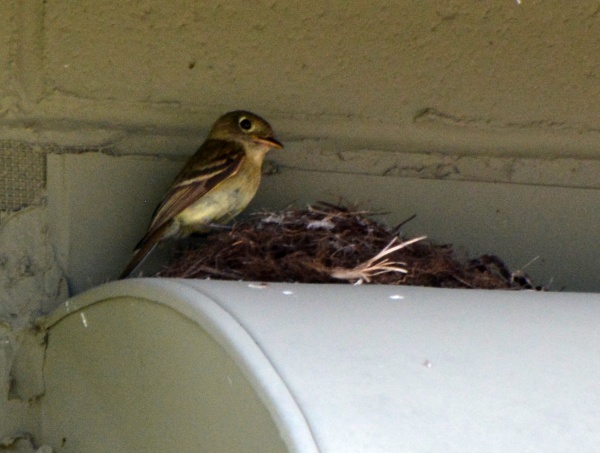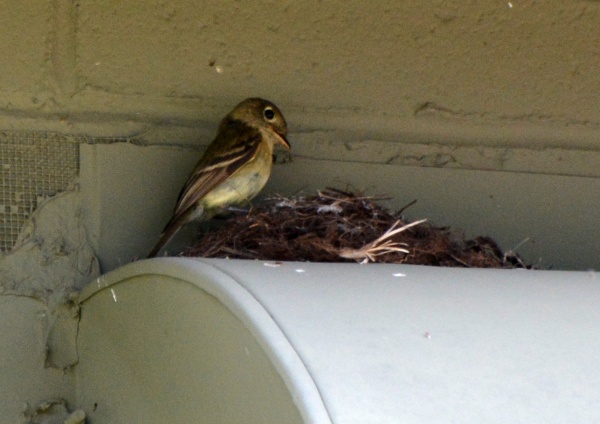
Last week, Karyn Delaney reported a northern cardinal using an old robin’s nest outside her window and we joked in email that the mother took this shortcut because it’s so late in the breeding season.
Cardinals rarely reuse nests but some songbirds do. On Monday Donna Memon and I found a Cordillean flycatcher at her(*) nest at the summit of Mount Lemmon. Because her nestlings were too tiny to see and the nest edges and “launch pad” had fecal evidence of active fledglings, we surmised she was reusing the nest.
Birds of North America Online (BNA) reports that Cordillerans in the Santa Catalina Mountains in Arizona — the location of Mount Lemmon — build a “cup of moss, sometimes mixed with bark strips or rootlets, [and] lined with fine grass or rootlets.” Cordillerans often reuse nests, sometimes in the same location for 20 years. Perhaps this nest has been recycled many times because it’s much sloppier than a simple cup.
In the next three photos the flycatcher feeds and watches her tiny nestlings but she has to hurry because …



… this is a late nesting. Winter comes early to Mount Lemmon and Cordilleran migration begins in mid-August so she’ll have to hurry.
It looks like she’s already saved time by reusing the nest.
(*) A NOTE ABOUT “Cordilleran and “she”: Empidonax flycatchers are notoriously hard to identify but the Cordilleran flycatcher is the Empid species that nests on the summit of Mount Lemmon, a sky island in southeastern Arizona. The Cordilleran’s look-alike relative, the Pacific slope flycatcher, is a low elevation bird. Also, for convenience I’ve called this bird a “she” but the males help feed the nestlings so we may have been watching a “he.” On the subject of “he/she” I am borrowing my husband’s Poetic License.
(photos by Donna Memon)

Interesting. I lived at the base of the Santa Catalinas (Sunrise and Kolb roads) for years, and loved going up Mt Lemmon and into the mountains while I was there. There was a five year drought while I was there, and it was capped by a big fire that destroyed Summerhaven. This was in 2003 — are there any remnants of that big fire, or has the area recovered completely since then?
Steve, we didn’t visit Summerhaven but we went above it to areas where we could see evidence of fire damage a while ago — we couldn’t tell how long. My previous blog about the tree that smells like vanilla (http://www.birdsoutsidemywindow.org/2015/08/05/smells-like-vanilla/) has fire-dead trees on the left of the first photo and intact trees on the right. As far as I know, Summerhaven has recovered.